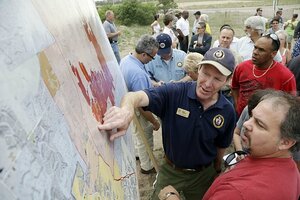Colorado fire: Is global warming one of the culprits?
Western wildfires like the Black Forest Fire in Colorado have been increasing in frequency and duration in recent years, burning far more land and with greater intensity. Scientists say climate change is a major factor.

Incident Commander Rich Harvey gives an update on the Black Forest Fire, to resident Dan Brennan during a press briefing in Colorado Springs, Colo., Friday. Firefighters held the line Friday on the Black Forest Fire, in which two people were killed as they tried to escape and 473 homes were destroyed.
Marcio Jose Sanchez/AP
Ashland, Oregon
Firefighters are beginning to get a handle on the massive Black Forest wildfire near Colorado Springs – the most destructive fire in the state’s history.
Cooler temperatures and some rain helped increase the contained area from just five percent Thursday to 30 percent Friday, authorities reported.
Still, the fire has been devastating: Two people killed and 38,000 evacuated, 473 homes destroyed as the blaze moved through 25 square miles of forests and woodland neighborhoods.
The Black Forest Fire in Colorado is part of a pattern in the West: increased construction in the “wildland-urban interface,” as it’s called.
Most homeowners adhere to zoning codes and other regulations requiring them to cut back trees, shrubs, and other natural fuels that can send fires racing through developed areas. Here in the mountains of southern Oregon, crews frequently are seen thinning the forested watershed above town.
Lightning strikes spark most wildfires, and unpaved roads into national forests and wilderness areas provide access to arsonists as well as to hunters and campers. (What started the Black Forest Fire is yet to be determined, but El Paso County Sheriff Terry Maketa suspects human causation.)
But experts now have little doubt that climate change has become a major factor in the number and intensity of wildfires.
“Today, western forests are experiencing longer wildfire seasons and more acres burned compared to several decades ago,” says Todd Sanford, a climate scientist at the Union of Concerned Scientists (UCS). “The greatest increase has occurred in mid-elevation Northern Rockies forests, which are having higher spring and summer temperatures and earlier snowmelt. These conditions are linked to climate change.”
“In general, climate change is increasing the risk for longer wildfire seasons and more area burned,” he says.
The UCS reports that wildfires in the western US have been increasing in frequency and duration since the mid-1980s, occurring nearly four times more often, burning more than six times the land area, and lasting almost five times as long.
“As the climate warms, moisture and precipitation levels are changing, with wet areas becoming wetter and dry areas becoming drier,” the organization reports. “Higher spring and summer temperatures and earlier spring snow-melt typically cause soils to be drier for longer, increasing the likelihood of drought and a longer wildfire season, particularly in the western United States. These hot, dry conditions also increase the likelihood that, once wildfires are started by lightning strikes or human error, they will be more intense and long-burning.”
To those tasked with preventing and fighting wildfires, climate change has become a major challenge.
“On average, wildfires burn twice as many acres each year as compared to 40 years ago. Last year, the fires were massive in size, coinciding with increased temperatures and early snow melt in the West,” US Forest Service Chief Tom Tidwell told the Senate Energy and Natural Resources Committee in testimony last week. “The largest issue we now face is how to adapt our management to anticipate climate change impacts and to mitigate their potential effects.”
In its report accompanying Mr. Tidwell’s testimony, the Forest Service detailed the increasing costs of fire-fighting.
Costs of fire suppression have increased to consume nearly half of the entire Forest Service budget. In fiscal year 1991, fire activities accounted for about 13 percent of the total agency budget. In fiscal year 2012, it was more than 40 percent. Since fiscal year 2000, the 10-year average cost has risen almost every year – from a little more than $540 million to more than $1 billion in 2010 and beyond.
During the past 10 years, the Forest Service has made fire transfers from non-firefighting accounts to pay for fire suppression costs six times, ranging from a low of $100 million in fiscal year 2007 to a high of $999 million in fiscal year 2002, and totaling approximately $2.7 billion. Of that total, $2.3 billion was repaid but led to disruptions within many Forest Service programs.
In Colorado, meanwhile, the US Department of Agriculture has designated six counties as primary natural disaster areas and six more as contiguous disaster areas due to ongoing severe drought conditions, US Senator Michael Bennet (D) of Colorado announced this week.
“Despite some relief earlier this year, right now we’re seeing how quickly our weather can get hot and dry, creating hazardous fire and drought conditions,” Sen. Bennet said.

